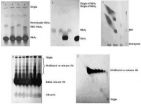(Press-News.org) Among known risk factors for hepatocellular cancer, smoking, obesity, and heavy alcohol consumption, along with chronic hepatitis B and C infection, contribute to a large share of the disease burden in Europe, according to a cohort study published online October 21 in the Journal of the National Cancer Institute.
While a causal link between hepatitis B and C and hepatocellular cancer has been known for a few decades, tobacco smoking, obesity, and alcohol consumption are common risk factors, albeit with lower relative risks, that also contribute to the development of the disease. In fact, there were many more Europeans with hepatocellular cancer who were smokers than carriers of hepatitis virus infections. Previous studies have not explored the contribution of each risk factor.
To determine the contribution of each of these risk factors to hepatocellular carcinoma, Dimitrios Trichopoulos, Ph.D., of the Harvard School of Public Health, and colleagues, used data from the European Prospective Investigation into Cancer and Nutrition (EPIC) study, which was established to investigate the role of biological, dietary, lifestyle and environmental factors in the etiology of cancer and other diseases in several European countries. The researchers matched 115 patients with hepatocellular carcinoma to 229 control subjects.
The researchers found that 47.6% of the cases of hepatocellular carcinoma in the cohort were associated with smoking, 20.9% with hepatitis C, 16.1% with obesity, 13.2% with hepatitis B, and 10.2% with heavy alcohol intake. They write, "We have shown that hepatocellular carcinoma, one of the most lethal human cancers, is largely amenable to primary prevention with existing knowledge and technology," noting that "although chronic infection with HBV and/or HCV was the strongest risk factor for hepatocellular carcinoma, tobacco smoking was responsible for more cases of hepatocellular carcinoma than either or both these viruses in the population."
In an accompanying editorial, Morris Sherman, M.D., and Josep M. Llovet, M.D., of the Mount Sinai School of Medicine write that this study's results are consistent with those from other epidemiological studies, but that the numbers need to be put into context.
Specifically, the editorialists caution against giving too much importance to smoking as a risk factor of hepatocellular carcinoma, since in this cohort, smoking was present in a large proportion of the population, thereby making the attributable risk more substantial than it might have otherwise been. If fact, they point out that no studies to date support the notion that smoking is a stand-alone risk factor for liver cancer. They also stress that the study does not explore combinations of risk factors in defining disease risk. Still, the data on smoking are noteworthy, they conclude. "We should be counseling our patients who have other risk factors for hepatocellular carcinoma to quit smoking. Of course, there are many other health reasons to stop smoking. Here is one more."
A second study on hepatocellular carcinoma in this issue of the Journal confirms the association between hepatitis B and hepatocellular carcinoma among a population cohort in Greenland. However, the study also finds that the Greenlanders studied have a relatively low incidence of hepatocellular carcinoma compared to those in other parts of the world, suggesting that a more benign course of Hepatitis B infection is prevalent in Greenland and accounts for the lower incidence of hepatocellular carcinoma there.
Marlene M. Børresen, M.D., Ph.D., of the Department of Epidemiology Research at Statens Serum Institut in Copenhagen, and colleagues, looked at a population of 8879 Greenlanders enrolled in populated-based serum surveys in 1987 and in 1998, who were followed until 2010. The researchers checked them for hepatitis B status, and found that those who were HBV positive had a much higher rate of hepatocellular carcinoma than those who were HBV negative. However, they also found that the incidence of hepatocellular carcinoma was much lower in Greenland than parts of the world that had a similarly high prevalence of hepatitis B.
The authors write that this finding could be attributable to a number of factors: for example, that the infection is transmitted typically during adolescence and adulthood, whereas infection during childhood carries a stronger risk for developing hepatocellular carcinoma; and that the strains of HBV that are associated with high risk of hepatocellular carcinoma are less common in Greenland than elsewhere. Furthermore, low smoking rates and alcohol consumption in Greenland may account for the lower rates of hepatocellular carcinoma, along with the relatively young age of the cohort studied (average age at recruitment was 33.4 years, with follow-up occurring in the mid-fifties.)
In an accompanying editorial, Morris Sherman, M.D., and Josep M. Llovet, M.D., of the Mount Sinai School of Medicine concur with the authors that genotype differences may in part account for the lower prevalence of hepatocellular carcinoma amongst those with HBV. The editorialists note that in Greenland, the D and B6 genotypes of HVB are most common, and that "the incidence of hepatocellular carcinoma in people infected by genotype B6 has not been documented." They add that viral load and infection by mutants of HBV are also risk factors of hepatocellular carcinoma that this study did not investigate.
INFORMATION:
Contacts:
Article: Dimitrios Trichopolous, dtrichop@hsph.harvard.edu ; +30 697 3 88 63 88; or Todd Datz, tdatz@hsph.harvard.edu ; 617-432-8413
rticle: Malene Landbo Børresen, MLB@ssi.dk; +45 3268 3268
Editorial: Josep Llovet, Josep.Llovet@mssm.edu; 212-659-9503
END
MARSABIT, KENYA (21 October 2011) – In the midst of a drought-induced food crisis affecting millions in the Horn of Africa, an innovative insurance program for poor livestock keepers is making its first payouts today, providing compensation for some 650 insured herders in northern Kenya's vast Marsabit District who have lost up to a third of their animals.
Known as Index Based Livestock Insurance or IBLI, payouts are triggered when satellite images show that grazing lands in the region have deteriorated to the point that herders are expected to be losing more than 15 ...
Professor Qin Wenbin from BaoTou Medical College first identified the hemoglobin (Hb) A2 phenomenon 30 years ago. His first paper on this phenomenon was published in Acta Biochimica et Biophysica Sinica, in Chinese, in 1981. Subsequent research investigating its mechanism was published in Chinese in the Chinese Biochemical Journal and Progress in Biochemistry and Biophysics in 1991 and more recently in Electrophoresis, in 2010. Using electrophoretic methods, he discovered that Hb is re-released in living red blood cells (RBCs) and demonstrated the significance of this process ...
After decades of decline, the worldwide death rate from full anesthesia is quietly creeping higher. According to an article recently published in the German Medical Association's official international science journal, the death rate during full anesthesia has reached approximately seven patients per million. In contrast, deaths from full anesthesia only affected four patients per million at the end of the 1980s. This disturbing trend may serve as a wakeup call to alert doctors that special precautions are warranted when anesthetizing at risk patients.
Reasons Anesthesia ...
Magnetic resonance imaging (MRI) is an established technique which over the years has made it possible for researchers and healthcare professionals to study biological phenomena in the body without using ionising radiation, for example X-rays.
The images produced by normal MRI are, to put it simply, pictures of water in the body, since the body is largely made up of water. MRI produces images of the hydrogen nuclei in water molecules. It can also be used to study other types of nuclei in many other interesting molecules. The only problem is that the concentration of ...
However, Svante Björck, a climate researcher at Lund University in Sweden, has now shown that global warming, i.e. simultaneous warming events in the northern and southern hemispheres, have not occurred in the past 20 000 years, which is as far back as it is possible to analyse with sufficient precision to compare with modern developments.
Svante Björck's study thus goes 14 000 years further back in time than previous studies have done.
"What is happening today is unique from a historical geological perspective", he says.
Svante Björck has gone through the global ...
The benefits of virtual worlds can be used to help autistic children develop social skills beyond their anticipated levels, suggest early findings from new research funded by the Economic and Social Research Council (ESRC). Researchers on the Echoes Project have developed an interactive environment which uses multi-touch screen technology where virtual characters on the screener act to children's actions in real time.
During sessions in the virtual environment, primary school children experiment with different social scenarios, allowing the researchers to compare their ...
Nearly one in three Americans will be involved in an alcohol-related crash at some point in their lives, according to data from the National Highway Traffic Safety Administration. In Pennsylvania, as in many other states, the law recognizes the fact that there is often more than one at-fault party in a drunk driving accident. Under a Pennsylvania statute known as the "dram shop law," business establishments and social hosts may be held liable when they serve alcohol irresponsibly to someone who later causes an injury.
Business Establishments
Pennsylvania ...
Celebrated writers such as Charles Dickens and George Eliot described characters' faces vividly without going into detail about their features, according to a research group led at the University of Strathclyde.
Experts in literature, psychology, neurology and music suggested that vividness can be created not only by describing individual features, such as the eyes, nose or chin, but by the strength of readers' feelings about how a person is depicted.
These feelings may be triggered by the 'mirror neuron system,' in which people who see an action being performed have ...
Finnish researchers found a new mechanism inhibiting the spread and growth of cancer found in motile cells
It has long been held that cells use different mechanisms for regulating migration and growth. This conception was proven false by research scientists Anja Mai and Stefan Veltel from the research team of Professor Johanna Ivaska. Their findings on aggressively spreading breast cancer cells revealed – completely contrary to previous expectations – that a single cell protein (p120RasGAP) acts as an important inhibitor of both cell migration and growth.
Cancer cells ...
A University of Michigan Health System-led team of researchers has found a biomarker they believe can help rapidly identify one of the most serious complications in patients with leukemia, lymphoma and other blood disorders who have received a transplant of new, blood-forming cells.
Known as a hematopoietic stem cell transplant, these patients receive bone marrow or peripheral blood stem cells from a matched donor who is either a family member or an unrelated volunteer.
The most common fatal complication of this type of transplant is graft-versus-host disease (GVHD), ...

